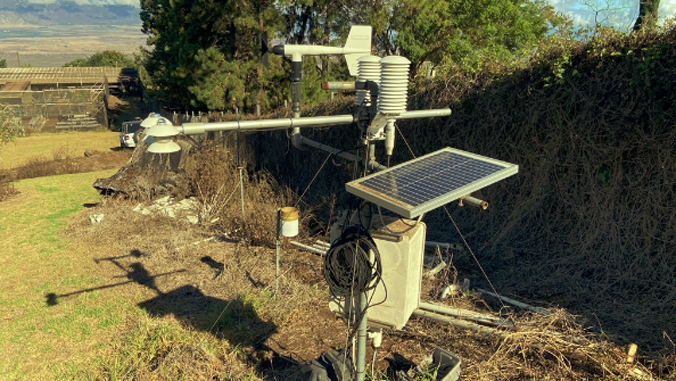In a first, the National Science Foundation (NSF) has awarded the University of Hawaiʻi at Mānoa a three-year, $1,334,481 grant to deploy dozens of climate stations across the state. “Hawaiʻi Mesonet” is a public impact research project to better understand and forecast the complex weather and climate of the Hawaiian Islands.
The mesonet or mesoscale network is a densely located set of observation stations. This is the first time the NSF has funded a mesonet system under its highly competitive Major Research Instrumentation (MRI) Program.
Thomas Giambelluca, the project’s principal investigator, and UH’s Water Resources Research Center director and Department of Geography and Environment professor, says the Hawaiian Islands have extreme differences in climate over a small land area. Long-term observational data on rainfall, temperature and soil are unavailable from many locations that would provide valuable information relevant to atmospheric science, hydrology and ecosystems science.
According to Giambelluca, who has decades of experience studying Hawaiʻi’s climate, “Place-to-place climate differences found in Hawaiʻi are equivalent to those of a continent, but compressed into the small area of the islands. For example, rainfall changes from 20 to 400 inches per year over a distance of about 12 miles. While we already have hundreds of rain gauges, they are not enough, not located in all the right places, and many are not equipped to send out the data. Temperature, humidity, wind speed, solar radiation and other variables are measured at relatively few locations. The Hawaiʻi Mesonet will meet the needs of researchers, weather forecasters, farmers, conservation organizations and many others by providing high-quality, comprehensive measurements over the whole state.”
The research team’s co-principal investigators are David Beilman, Department of Geography and Environment professor; Abby Frazier, affiliate graduate faculty in the Department of Geography and Department of Earth Sciences, and assistant professor at Clark University; Alison Nugent, Department of Atmospheric Sciences assistant professor; and Yin-Phan Tsang, Department of Natural Resources and Environmental Management associate professor.

Hands-on learning experience
UH Mānoa students and post-doctoral researchers will install 84 climate stations in some of the most remote parts of the state. Stations will each have a data logger, power supply with solar charging and a telecom device allowing for real-time data transmission. They will gain hands-on field experience in instrument installation, calibration and maintenance, while collaborating with water and natural resource managers, fire departments, and state and federal organizations. The data collected will be incorporated in classes and the researchers will work with programs intended to boost the involvement of Native Hawaiian students in research.
Project goals
After collecting and analyzing the data, Giambelluca hopes the team will eventually be able to predict the probability thunderstorms may form by a process called convective initiation; identify water basin storage thresholds to better estimate the risk of flooding to low-lying areas; and discover the interactive effects of temperature, moisture and solar radiation on ecosystems.
Data will also be used to form the Hawaiʻi Climate Data Portal where users—including weather forecasters—can receive real-time data. Data will also be submitted to the National Mesonet Program supported by the National Oceanic and Atmospheric Administration.
Beilman said, “The real-time high-resolution data availability will be unprecedented, and will allow us to better know how ‘hot moments’ and hotspots really work. A network in Hawaiʻi that connects climate from busy urban areas to remote mountains is truly novel.”
Nugent, whose research focuses on atmospheric science and weather forecasting, said, “I’m most excited with having more observations. Right now, in order to get observations together to do more research, it takes a lot of pre-work. You have to make sure the time stamps are lined up correctly and the data is quality controlled. But this will put everything all in one place. It will make it much more useful and much easier for students to use and researchers to use.”
Tsang’s research is focused on hydrology (study on the distribution of water on or below the surface) and she is looking forward to having more data to understand the water balance across all Hawaiian islands.
“The network we are building will include measurements of soil moisture, which is important in order to help us understand how to balance the water budget across all watersheds and describe the antecedent moisture condition to accurately predict floods. This will be a huge help to our emergency response agencies,” Tsang said.
Frazier added, “I study the spatial patterns of climate in Hawaiʻi and how climate variations affect water resources, and this new network will allow us to better understand the spatial details of climate extremes like drought and heavy rainfall events.”
Community engagement
Giambelluca’s team is seeking assistance from the community for two reasons: 1) landowners willing to offer their area to host a weather station and 2) landowners or other community members willing to help the team maintain the stations over time. Those interested in assisting with the project may contact Giambelluca at HCDP@hawaii.edu.
This work is an example of UH Mānoa’s goals of Excellence in Research: Advancing the Research and Creative Work Enterprise (PDF), Building a Sustainable and Resilient Campus Environment: Within the Global Sustainability and Climate Resilience Movement (PDF) and Enhancing Student Success (PDF) three of four goals identified in the 2015–25 Strategic Plan (PDF), updated in December 2020.
—By Marc Arakaki

